BENGALURU– Saudia (SV), the national flag carrier of Saudi Arabia previously known as Saudi Arabian Airlines, has been gradually curtailing its operations in India for a few months now.
This is surprising considering the high potential and strong demand in the aviation market between India and Saudi Arabia, known for its frequent passenger traffic and economic connectivity.
The move to reduce the operations of Saudia is rather surprising, especially at a time when other airlines from both sides, from India and Saudi Arabia, are simultaneously expanding into this flourishing market to cater to ever-growing demand.
When the observations were made, one surprise was that Saudia does not have any flights to India from Dammam (DMM), one of Saudi Arabia’s most important cities, though direct flights are offered by several other competing airlines between Dammam and destinations across India.
Air connectivity between India and Saudi Arabia is quite flourishing, as lots of airlines fly in this high-demand corridor.
Interestingly, all Indian carriers with narrowbody fleets, which include popular low-cost and full-service airlines, engage in the trade between India and Saudi Arabia.
The market thus works upon the very major demand for connections whilst in the region. Airlines such as Kuwait Airways (KU), Gulf Air (GF), Qatar Airways (QR), Etihad (EY), etc… offer attractive connections to Saudi Arabia via their specific hubs in the Middle East.

Saudia India Flights Reductions
While the airline is yet to return to pre-COVID-like connectivity between Saudi Arabia and India, particularly from Riyadh (RUH), southern India has seen a major impact of the airline’s scale back.
Traditionally, Bengaluru (BLR), Chennai (MAA), and Hyderabad (HYD) have had strong demand for travel to and from Saudi Arabia and are among the cities most affected by Saudia’s cuts in routes.
These cities are major hubs for business travel, pilgrimages, migrant workers, etc., and in such circumstances, the downscaling hit them harder, mostly forcing them into other airlines or inconvenient connecting flights to reach Saudi Arabia.
Besides, Saudia has downgraded the size of the aircraft on several of the routes, particularly taking out the larger Boeing 777-300ER and replacing it with the smaller Airbus A330-300. The downgrade cuts down on the number of available seats, compounding the already difficult situation of the key markets.
Cities with the Most Impact

- Bengaluru (BLR)- The frequency of flights operated by Saudia from Bengaluru to Jeddah has drastically reduced from daily to four times a week. This limits the options available for passengers willing to head to this commercially vibrant capital of the Karnataka state. Even though demand is strong, the airline has not yet restored its pre-COVID Riyadh-Bengaluru service which was a crucial connection for its guests.
- In a welcome turnaround, IndiGo (6E) started Bengaluru-Jeddah flights in September 2024, giving passengers more options on a non-stop basis, and thus partially filling the void left by Saudia’s reduced operations.
- Chennai (MAA)- Chennai perhaps took the biggest hit, with Saudia previously operating non-stop flights from Jeddah and Riyadh to the city bustling with demand for travel to Saudi Arabia.
To the surprise of all, the airline has recommenced Chennai-Jeddah flights from October 2024 only post-COVID, evidently after a long break. The Riyadh-Chennai route is still suspended, with no reopening planned so far.
Even more disturbing for the people of Chennai is that a mere two-weekly flight from Chennai to Jeddah is set to cease operations beyond December 30th, 2024. This will once again leave Chennai without flights by Saudia.
Consequently, passengers from that city will have to only option of Air India Express, which has got two flights a week to Dammam from Chennai, as the sole direct service towards Saudi Arabia.
- Kochi (COK)- Kochi, one of Kerala’s major cities, previously enjoyed daily flights by Saudia from both Jeddah and Riyadh. Though the airline continues to operate flights to both Jeddah and Riyadh but with a reduced frequency.
The airline now operates 5x weekly flights from both Jeddah (JED) and Riyadh (RUH) to Kochi (COK).
- Hyderabad (HYD)- Saudia’s flights from Hyderabad, situated in the capital city of Telangana, were also brought down. Earlier, these had been daily flights operated from Jeddah, and from Riyadh, 3 to 4 times a week. As of now, Jeddah has dwindled to six operations a week, whereas, during November 2024, the Riyadh-Hyderabad route was briefly plummeted to just one operation a week, and was completely deleted on November 30th, 2024.
The Effect
Flight cancellations extensively affected connectivity and left passengers with limited non-stop options, especially after Saudia Airlines also canceled the Riyadh-Hyderabad route.
Delhi (DEL) and Mumbai (BOM) haven’t been able to restore their pre-COVID traffic. These two cities used to have daily frequencies, at times more; however, at present, traffic is less than daily. Given the consistent level of demand, this is a strange move.

Why these Cuts?
The reasons for Saudia’s scaling back remain unclear. Is it because the low yields characterizing the India-Saudi Arabia market result in ticket fares that are unacceptably low to sustain profitability? Alternatively, possibly the airline wide-body aircraft with their necessarily higher cost are presenting challenges in a price-sensitive Indian market.
Another reason could be that Saudia sticks to a much larger Full-Service Carrier (FSC) model as opposed to that which is held by Indian and Middle Eastern competitors, most of whom operate on narrowbody aircraft more suitable for short- to medium-haul feeder routes.
Interestingly enough, Saudia is the only airline operating wide-body aircraft on the route between India and Saudi Arabia, while the rest use narrow-body jets. Given that wide-body planes are larger, they have to achieve higher passenger loads and ticket prices in order to be viable as an option. This might not be achievable consistently in certain sectors.

A Strategic Shift?
In what could indicate a change in perspective, Saudia has announced its plans to use A321 narrow-body aircraft on the Riyadh-Kozhikode route beginning February 2025. This is the first time ever that the airline is deploying narrow-body aircraft to India.
It might also indicate an initial effort by the airline to find its bearings in a challenging business environment where operating costs can be kept in check, hopefully, to realize operational efficiency on routes that may not have the demand to see wide-body capacity.
This will also mark what could very well be an escalated competition with airlines in the region. It can only be said whether this is a one-off or whether it marks the beginning of a larger shift.
The Challenges of a Low-Yield Market
The India-Saudi Arabia sector has traditionally been categorized as a low-yielding market, mainly driven by the demographics of its passengers. A large share of the clientele involves religious pilgrims and blue-collar workers on employment contracts in Saudi Arabia. This essentially allows for a minute share of business travel, usually the airline’s most profitable section.
Perhaps this is what explains Saudia’s continuous struggle to make profits. This sector perfectly suits the Low-Cost Carrier (LCC) model, rather than that of the Full-Service Carrier (FSC).
A Trend Among FSCs
Air India (AI), the only other full-service carrier that operates flights for Saudi Arabia besides Saudia (SV), is strategically minded because of the problem in this sector. The airline has moved certain India-Saudi Arabia routes to its low-cost subsidiary, Air India Express (IX), which shows the price-sensitive nature of the market.
This should signal the hardship of sustaining FSC operations in a market under constant pressure from economic constraints, as well as LCCs’ competition for ticket sales. For Saudia, this market reality may necessarily imply a rethinking of its strategy to ensure long-term competitiveness.

A New Player in the Skies of Saudi Arabia
Riyadh Air, Saudi Arabia’s second flag carrier, is a fresh airline set to come to the fore in the aviation industry.
Officially launched on March 12, 2023, it wants to position itself as a world-class Full-Service Carrier headquartered in Riyadh, modeled after successful hub models of Emirates, Etihad, and Qatar Airways.
Riyadh Air has ambitious growth plans, driven by an order for 99 aircraft including 60 Airbus A321 and 39 Boeing 787-9 Dreamliner.
India: Key Market for Riyadh Air
India is all but sure to become a key area for Riyadh Air as it aims to put Riyadh in the global connection hub.
The entry of this airline into the Indian market seems almost a given, with the only uncertainties remaining to be resistance from the old guard and whether the airline will escape the hurdles faced by Saudia.

Making it Work in India
To flourish in India, Riyadh Air will need to adopt a careful strategy. Targeting major metro cities with a large amount of traffic to Europe, the US, and Canada could present it with a vital competitive advantage.
There is, therefore, merit in taking the step towards launching such routes from Delhi (DEL), Mumbai (BOM), or Bengaluru (BLR), as they have high population density and rapidly growing demand for international travel.
Further, the state-of-the-art fleet of Riyadh Air and its ambition to build a seamless global hub in Riyadh might offer Indian passengers attractive choices for one-stop connections to various destinations around the world.
This differentiator-hedged with superior service and connectivity could help Riyadh Air carve out a niche for itself in a market typically dominated by Low-Cost Carriers (LCC).
Challenges Ahead
While competition from established players and low yields could hamper Riyadh Air’s capturing of the Indian market, it’s promising some contenders to test the waters.
Inside Riyadh Air, it’s going to be a balance of good demand, good pricing, and operational cost, which could either allow it to grow or cause its failure in the Indian market.
Feature Image by Clément Alloing | Flickr
Stay tuned with us. Further, follow us on social media for the latest updates.
Join us on Telegram Group for the Latest Aviation Updates. Subsequently, follow us on Google News

